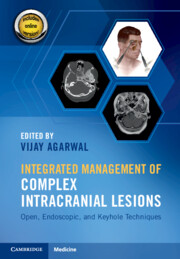Book contents
- Integrated Management of Complex Intracranial Lesions
- Integrated Management of Complex Intracranial Lesions
- Copyright page
- Dedication
- Contents
- Contributors
- Foreword
- Section I Endoscopic Endonasal (EN) Combined Approaches
- Section II Open Combined Approaches
- Chapter 6 Combined Transcranial Approach for Tumor Resection and Anterior Circulation Vascular Bypass
- Chapter 7 Hybrid/Combined Strategies for Vestibular Schwannomas
- Chapter 8 Transchoroidal, Subchoroidal, and Combined Approaches to the Third Ventricle
- Chapter 9 Combined Orbitofrontal Craniotomy and Direct Orbital Decompression
- Chapter 10 Transbasal and Transfacial Approach for Paranasal and Anterior Cranial Fossa Tumors
- Chapter 11 Combined Middle Fossa Craniotomy and Mastoidectomy for Cerebrospinal Fluid Leak Repair and Encephalocele Resection
- Chapter 12 Transcochlear and Extended/Combined Transcochlear Approaches for Complex Tumors of the Skull Base and Posterior Cranial Fossa
- Chapter 13 Combined Retrosigmoid and Orbitozygomatic Approach
- Chapter 14 Combined Retrosigmoid and Limited Anterior Petrosectomy (“Reverse Petrosectomy”)
- Chapter 15 Combined Suboccipital Craniotomy and Neck Dissection
- Chapter 16 Combined Petrosal Approach
- Chapter 17 Combined Keyhole Paramedian Supracerebellar-Transtentorial Approach
- Chapter 18 Combined Multi-portal “Pull-Through” Keyhole Craniotomy
- Chapter 19 Combined Keyhole Craniotomies for Multifocal or Multiple Lesions
- Chapter 20 Combined Microsurgical and Endovascular Treatment of Cerebrovascular and Skull Base Pathology
- Chapter 21 Combined Transsylvian-Subtemporal Approach to Anterior Circulation and Basilar Apex Aneurysms
- Index
- References
Chapter 9 - Combined Orbitofrontal Craniotomy and Direct Orbital Decompression
from Section II - Open Combined Approaches
Published online by Cambridge University Press: 05 October 2021
- Integrated Management of Complex Intracranial Lesions
- Integrated Management of Complex Intracranial Lesions
- Copyright page
- Dedication
- Contents
- Contributors
- Foreword
- Section I Endoscopic Endonasal (EN) Combined Approaches
- Section II Open Combined Approaches
- Chapter 6 Combined Transcranial Approach for Tumor Resection and Anterior Circulation Vascular Bypass
- Chapter 7 Hybrid/Combined Strategies for Vestibular Schwannomas
- Chapter 8 Transchoroidal, Subchoroidal, and Combined Approaches to the Third Ventricle
- Chapter 9 Combined Orbitofrontal Craniotomy and Direct Orbital Decompression
- Chapter 10 Transbasal and Transfacial Approach for Paranasal and Anterior Cranial Fossa Tumors
- Chapter 11 Combined Middle Fossa Craniotomy and Mastoidectomy for Cerebrospinal Fluid Leak Repair and Encephalocele Resection
- Chapter 12 Transcochlear and Extended/Combined Transcochlear Approaches for Complex Tumors of the Skull Base and Posterior Cranial Fossa
- Chapter 13 Combined Retrosigmoid and Orbitozygomatic Approach
- Chapter 14 Combined Retrosigmoid and Limited Anterior Petrosectomy (“Reverse Petrosectomy”)
- Chapter 15 Combined Suboccipital Craniotomy and Neck Dissection
- Chapter 16 Combined Petrosal Approach
- Chapter 17 Combined Keyhole Paramedian Supracerebellar-Transtentorial Approach
- Chapter 18 Combined Multi-portal “Pull-Through” Keyhole Craniotomy
- Chapter 19 Combined Keyhole Craniotomies for Multifocal or Multiple Lesions
- Chapter 20 Combined Microsurgical and Endovascular Treatment of Cerebrovascular and Skull Base Pathology
- Chapter 21 Combined Transsylvian-Subtemporal Approach to Anterior Circulation and Basilar Apex Aneurysms
- Index
- References
Summary
Orbitofrontal craniotomy with direct orbitotomy gives broad surgical access to the anterior cranial fossa and orbit. Indications for this combined technique vary and are dependent on the location and nature of the lesion. This technique can also be used for orbital decompression in severe cases of Graves’ orbitopathy. A complete clinical history with imaging is critical for preoperative planning. Postoperatively, close monitoring of vision and neurological status is critical to identifying and preventing complications.
Keywords
- Type
- Chapter
- Information
- Integrated Management of Complex Intracranial LesionsOpen, Endoscopic, and Keyhole Techniques, pp. 95 - 103Publisher: Cambridge University PressPrint publication year: 2021

